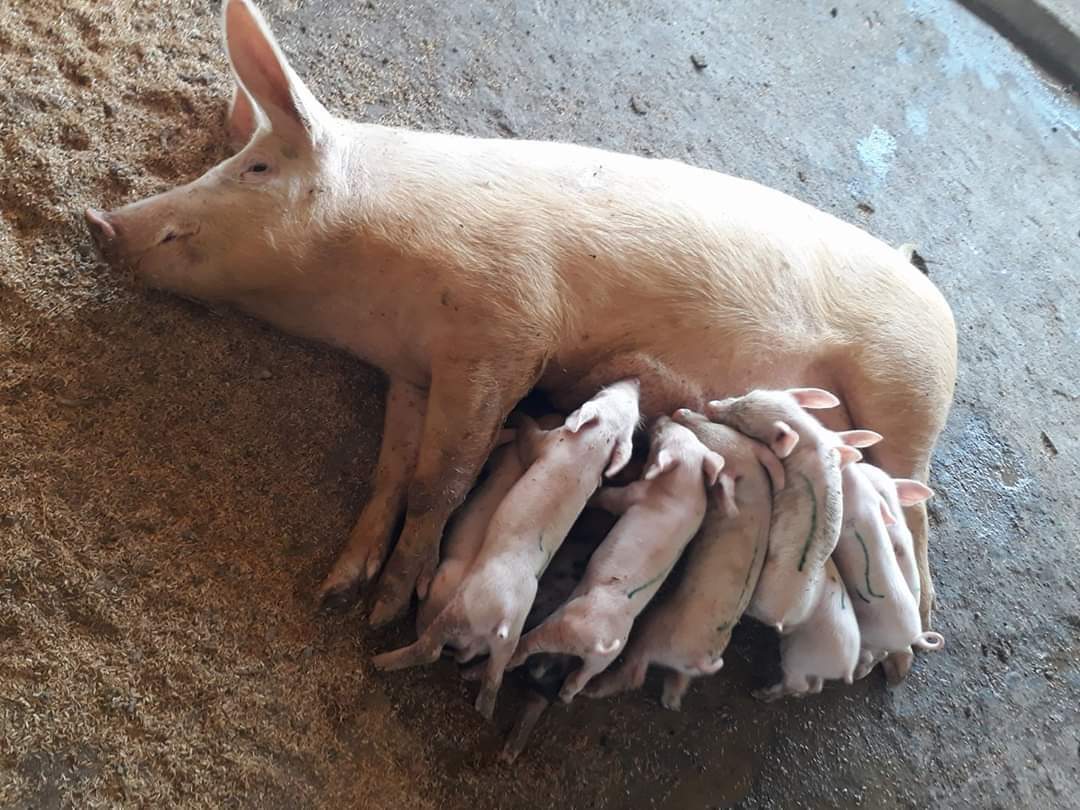Swine Fever or Classical Swine Fever(CSF)/Hog Cholera
Swine fever,Classical swine fever (CSF), otherwise known as hog cholera (HC) or just swine fever, is a specific viral disease of pigs. It affects no other species.
Clinical signs:
Acute disease
A constant early sign, which persists throughout the disease until just before death, is a high fever, over 42ºC (107ºF). Check the sick pigs’ rectal temperatures. If they are all high suspect CSF.
Clinical signs usually appear first in a small number of growing pigs which show non-specific signs of depression, sleepiness, and reluctance to get up or to eat. If you get them up they may wander to the feeder but eat very little or nothing and wander away again to lie down. They walk and stand with their heads down and tails limp. Over the following few days these signs get worse and more pigs become affected.
Younger piglets may appear chilled, shiver and huddle together.
vomiting.
diarrhoea.
red or dark skin, particularly on the ears and snout.
swollen red eyes.
laboured breathing and coughing.
abortions, still-births and weak litters.
nervous signs, eg convulsions and tremors in newborn piglets.
weakness.
Initially affected pigs may appear to be constipated but this generally changes to a yellow-grey diarrhoea as the disease progresses.
Early on some of the pigs may develop conjunctivitis (inflammation of the eye surface) with thin discharges.
This gets worse, the discharge getting thicker with time until some of the eyelids are completely closed and adhered.
As the disease progresses the affected pigs become very thin and weak and develop a staggering walk.
Diarrhoea worsens and some pigs vomit a yellowish bile. The pigs’ skins go purple, first over the ears and tail, followed by the snout, lower legs, belly and back.
Chronic and aberrant disease and persistent infection
The virus can cross the placenta and infect the piglets in the sow’s uterus.
Sows that have been inadequately vaccinated that become infected, or sows which become infected with a virus of low virulence, may appear normal but give birth to shaking piglets many of which die. (Note: there are also other causes of shaking or trembling piglets).
If the virus crosses the placenta before the piglets’ immune systems have developed they may be born apparently healthy although possibly weak and may grow on to be persistent carriers without at first showing clinical signs. They shed virus so they are a menace to other pigs.
Virus that infects the piglets in the uterus may cause other effects, namely, death, mummification, abortion or the birth of weak piglets .
Diagnosis
In acute or sub-acute outbreaks a presumptive diagnosis can be made on the typical clinical signs and post-mortem lesions but African swine fever and Salmonella choleraesuis infection produce some similar signs and lesions. Salmonella choleraesuis is frequently a concurrent pathological infection with CSF virus, triggered off from its latent state by the CSF virus infection.
In chronic or aberrant cases the clinical signs and lesions are less diagnostic and may only raise a suspicion of CSF.
In all suspected cases laboratory tests should be done to confirm the diagnosis. Investigations are usually carried out by the authorities.
It is best to send whole dead pigs to the diagnostic laboratory so the pathologists can sample what they want. If only samples can be sent the tonsils are best.
Post-mortem
Swine fever larynx
Larynx of pig with swine fever, note haemorrhaging (red and dark black areas)
Swine fever kidney
Kidneys showing small pinpoint heammorrahges.
Swine fever Pleura
Haemmorrhaging inside chest cavity.
The tonsils of the pig are very easy to find.
Samples for laboratory
Virus is present throughout the body.
spleen, kidneys and last few inches of the small intestine (before it meets the large intestine).
The laboratory should be able to carry out rapid tests and let you know the diagnosis on the same day they receive the samples.
These viruses can cause trans-placental infection of unborn piglets in the sow’s uterus resulting in infertility and piglet problems similar to those of CSF. Such congenital infection may also result in newborn piglets which are shedding virus and thus infecting other pigs.
The stomach and gut are usually empty except for scant liquid which may be brightly coloured. Fairly unique lesions to look for are raised so-called ‘button ulcers’ on the inner lining of the large intestine near its junction with the small intestine.
Management control and prevention
Vaccination
In enzootic and high risk areas routine vaccination is practised and may be compulsory.
Pigs develop protective immunity one week to ten days after vaccination and the immunity lasts two to three years (i.e. the lifetime of many sows and boars). Piglets which are suckled by vaccinated sows receive colostral protection which lasts about 6-8 weeks. During this time they cannot be vaccinated successfully because the matern
In a circumscribed region in which the CSF virus is endemic it is usual to blanket vaccinate all pigs over two weeks of age initially. Piglets born to vaccinated sows would be vaccinated over 8 weeks age.
prevent re-infection from outside by controlling the importation of pigs and pig meat products, unless they have been well processed, from regions in which the CSF virus is still present.
In addition, swill (waste human food) containing meat products must be sterilised by heating .
By Dr.Parvinder Kaur Lubana,VO, RDDL, Jalandhar, Punjab


